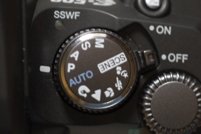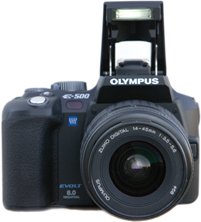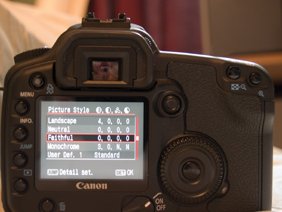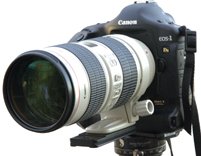Price
| For most people, price is the most important issue when looking at a camera. Until a couple of years ago, you'd have to budget well over $1,000 to purchase a digital SLR and basic lens. Today a full-featured camera can be found for less than $600. Cameras in this entry-level category, such as the Canon EOS Digital Rebel line and the Olympus E Series, are optimized for ease of use while still giving you a number of advanced features and access to the full line of lenses. Note You'll quickly discover that the camera body is often the least expensive part of your purchase. Lenses, particularly high-quality ones, can easily exceed the price of the body. The good news is that you can use your expensive lenses on a new body if you upgrade later. Entry-level CamerasAt the entry-level end of the dSLR price scale, which I'm defining as costing $700 and less, you'll find a number of cameras, often available with a kit lens, which is typically a zoom lens of normal to telephoto length. These cameras are typically in the 6- to 8-megapixel range and offer a number of automatic settings designed to produce good results without having to learn and master all the manual options and controls. Although excellent images can definitely be captured with these cameras, the photographer does sacrifice a significant amount of creative control. Common to all cameras in this range are image settings for different modes, like Sports, Portrait, Landscape, and Automatic, as you see in Figure 1.3. Figure 1.3. Most entry-level cameras offer a full set of image settings designed to help you get good results with minimal fuss.
These entry-level cameras are all designed to be easy to use, which makes them a good transition stage from a point-and-shoot. They're commonly lightweight and fairly smallespecially compared to their pro-level counterparts. At its most basic, you can turn an entry-level dSLR camera on and use it as a point-and-shoot, without knowing anything about photography, by leaving the camera on its Program (P) or Auto (A) mode for automatic shutter-speed and aperture settings. When you're ready to move beyond Program, the other mode settings common to these camerastypically Sports, Landscape, Portrait, and Macrowill help you learn more about exposure while still getting the best possible results. Also common to cameras in this category is built-in flash for shooting in low light. The integrated flash pops up from the camera body (Figure 1.4) when needed, either automatically, based on shutter speed, or manually when you want to add a bit of fill light to an image. Although not as flexible or powerful as an external flash, you can't beat the convenience of having one always available. Figure 1.4. Pop-up flash is standard on all entry-level and most mid-level cameras, but not the pro-level bodies.
Entry-level dSLR cameras normally allow you to capture images at a rate of 3 frames per second, making it easier to photograph moving objects. Most have enough onboard memory to record a dozen or more images before filling the memory buffer and slowing down in order to record the images to your memory card (see the "Memory Cards" sidebar).
Mid-level or "Prosumer" CamerasAt the next level is the group of cameras in the sub-$2,000 range, such as the Canon EOS 30D (Figure 1.5) and the Nikon D200. These are full-featured bodies that offer larger buffer sizes. The buffer is the capacity for temporarily storing images before the camera has to write them to the memory card, which creates a slight delay when taking a batch of pictures in a row. This level of camera offers a faster frame-capture rate than entry-level cameras, often around 5 images per second. Figure 1.5. The Canon 30D is an example of the mid-level range. At less than $1,500, you get a number of enhancements over the entry-level without sacrificing ease of use.
With mid-level cameras you benefit from faster focusing, options such as bracketing for different f-stops or shutter speeds, and in some cases, more sensitive meters that can deal with a wider range of lighting conditions to deliver accurate results in sharpness and exposure. Most mid-level dSLR cameras also include a built-in flash and faster flash synchronization, allowing you to capture images with higher shutter-speed options. Cameras in the mid-level range are more ruggedly built than the entry-level ones, with stronger lens mounts (usually metal rather than plastic) and more robust parts (such as sturdy shutters designed to last longer). You still have the Program mode options featured in entry-level cameras and, in some cases, there are specialty modes that go under different names, such as Picture Styles (Figure 1.6), for optimizing camera settings for black-and-white or sepia toning, for example. Figure 1.6. Picture Styles are a helpful feature that can quickly set your camera for special effects like black and white or sepia tones.
Note You get a complete rundown on flash use, sync speeds, and all the other magical features of flashes in Chapter 5. Many pro photographers and wedding photographers use mid-level cameras as either a primary camera or a backup to their main camera. In fact, I carry one in addition to my heavy pro-level camera and find myself using it a lot. It's lighter than my pro-level camera, less obvious when I'm out in a crowd, and the built-in flash is extremely handy. Pro-level CamerasThe price tag of pro-level cameras (such as the Canon shown in Figure 1.7) puts them out of reach of most users except professionals who make a living from their photographs. You can expect to pay between $3,500 and $8,000 or more for a manufacturer's top-of-the-line camera body. Pro-level cameras are produced adhering to precise standards and tolerances with very durable materials in order to meet the challenges of daily use in a professional environment. These camera bodies are constructed with a sturdy titanium chassis and a polycarbonate shell. They include seals around all doors, buttons, and other areas where moisture or dust could seep in and cause a problem. The circuitry features gold contacts to prevent corrosion, and the camera is inspected and tested thoroughly to ensure that it meets the strict standards demanded by professional photographers. Figure 1.7. At the pro level, you get speed and durability along with faster focusing and other features designed for the working pro.
Along with superior build quality comes extra weight, though. Most of these cameras are twice as heavy as prosumer bodies. Pro-level cameras offer increased frame rates, up to 8.5 frames per second on the Canon 1D Mark IIN, and more metering options, such as adjustable spot metering, that helps refine the exposure area. (I cover metering modes in Chapter 4.) Shutter speeds increase as well, to 1/8000 of a second, which is ideal for fast-action shooting in racing and other sports. You also find buffer sizes of 20 or more images to allow long sequences of images to be captured. The professional level is also the only place you'll find a full-frame sensora sensor that's the same dimension as a frame of 35mm film. Currently, the Canon 5D and the Canon 1Ds Mark II use full-frame sensors, and more models are expected. Some of these high-end bodies include dual memory-card slotsusually for CF and SD cardsgiving you more memory options and allowing you to write different image formats to different cards. Although built to handle the needs of a working pro, there are valid reasons for the amateur photographer to consider a pro-level camera. If you're a fan of macro, or close-up, photography, these cameras allow you to lock the mirror before pressing the shutter to minimize any movement that's magnified with this type of photography. You'll also find support for longer exposures (compare the slight blur of Figure 1.8a with the sharper Figure 1.8b). Figure 1.8a. Macro photography can accentuate any movement in the camera, even the slight vibration from the mirror moving out of the way.
Figure 1.8b. Here's the same image with mirror lock-up used to eliminate movement. Camera settings were 1/30 second at f/16.
It may surprise you to know what you don't get with a pro-level camera. None of these cameras include an Automatic scene mode. You'll find Program, Aperture Priority, Shutter Priority (or Time Value), and Manualsettings that are familiar to professional photographers. You won't find a built-in flash with pro-level bodies either, which I find disappointing. Regardless of your photography level, sometimes a built-in flash is perfect for the task at hand. Instead, photographers at this level are expected to use sophisticated (and bulky) external light units. |
EAN: 2147483647
Pages: 91






